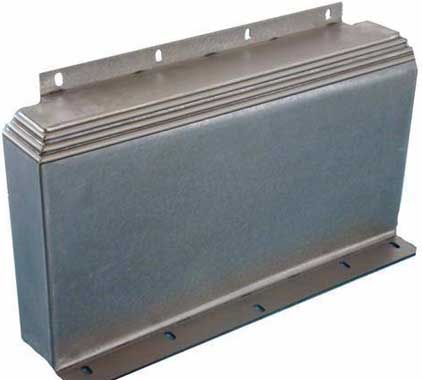Electrostatic Protection (ESD) Process Design of Sheet Metal Cabinet
The non-conducting body generates an electrostatic charge due to friction, heating or contact with other electrostatically charged bodies.
When the electrostatic charge accumulated to a certain electric field gradients (Gradient of Field), it will lead the arc (Arc), or a suction force (Mechanical Attraction).
Such a phenomenon in which energy is released by an electric arc due to static electricity accumulation of a non-conductor is called ESD.

1-1 Factors affecting the electrostatic charge of objects
Material factor
The electrical conductor --- charge is easy to neutralize, so it does not accumulate static charge.
Non-electrical conductors --- large resistance, charge is not suitable for resonance (Recombination), resulting in charge accumulation.
The larger the relative dielectric constant (Dielectric Constant) between the two contact materials (non-conducting bodies), the easier it is to carry static electricity.
Triboelectric Table
When the surface resistance of the material is greater than 109 ohms/square, it is easier to carry static electricity.
|
0 ohms/square~106 ohms/square conductor 106 ohms/square~109 ohms/square Non-static material 109 ohms/square~ ∞ Easy to cause static material |
| Conductive PE FOAM | 104~106 ohms/square |
| Antistatic bag | 108~1012 ohms/square |
|
Antistatic material |
10~108 ohms-cm |
2. The lower the relative humidity in the air, the easier it is to carry static electricity.
ESD parameter characteristics
Capacitor
The basic relationship of ESD : V=Q/C
Q is the amount of static electricity carried by the object. When Q is fixed, the lower the capacitance of the electrostatically charged object, the higher the ESD voltage released.
Usually women's capacitance is higher than men's, the general human body capacitance is between 80pfd~500pfd.
2. Voltage
One of the main causes of IC component failure is the voltage released by the ESD. The human body usually has an electrostatic discharge voltage of 10 to 15 kV due to friction, and the ESD voltage that can be generated does not exceed the upper limit of 35 to 40 kV. The lower limit of the ESD voltage that the human body can sense is 3~4kV
3. Energy
W=1/2 *CV2
Typical ESD energy is about 17 milijoules, ie when C=150 pfd, V=15kV
W=1/2 * 150 *1012 * (15 * 103)2 =17 * 103 joules (joule)
4. Polarity
The static electricity carried by the object has positive and negative points. When a certain polarity causes the component to move toward the Reverse Bias, the component is more easily destroyed.
5. RISE TIME ( tr )
RISE TIME---ESD start pulse (PULSE) The time required for the peak value of 10% to 90% ESD current.
Duration--- Time elapsed between 50% of the ESD start pulse and 50% of the drop pulse
Discharge with a sharp tool, resulting in the shortest ESD Rise time and maximum current.
ESD production can be divided into five phases:
1. Corona Discharge, which produces RF radiation.
2. Advanced electric field discharge (Pre-discahrge E-Field)
3. Electric field discharge collapse (Collapse)
4. Magnetic field discharge (Discharge H-Field)
5. Current is released and generates transient voltage (Transient Voltage)
1-2 ESD Problems in Electronic Equipment
Direct discharge to electronic components
Voltage-induced damage
(1) Based on MOS (Metal Oxide Semiconductar) DEVICE
(2) When the ESD voltage exceeds the Breakdown Voltage of the oxide layer (such as SiO2), the component is destroyed.
(3) caused by electric field
Current-induced damage
(1) In BIPOLAR (Schottky, TTL) DEVICE main
(2) When the ESD current reaches 2~5A, the high heat (I2t) due to the Joule effect burns the IC JUNCTION.
(3) caused by a magnetic field
2. Direct discharge to the electronics housing
When the electrostatically charged human body contacts the metal casing of the electronic equipment, if the equipment is grounded, the ESD current will flow directly to the ground wire, otherwise it may flow through the electronic components and then flow to the GROUND, causing damage to the components.
Since the ESD current is transmitted to the ground via the path with the lowest impedance, if the dynamic impedance of the ground line is lower than the impedance of the cabinet to the ground/desktop, there may be a case that is transmitted to the ground, which may cause radiation interference to the electronic circuit.
3. Indirect discharge
Indirect discharge---- means that the electrostatically charged body is not directly discharged to the equipment department that is in contact, but is discharged to adjacent metal parts, causing ESD PILSE to cause electromagnetic field radiation to affect the electronic components.1-3 ESD protection design
1. Component Level
2. Board Level (PCB Level)
3. CABLING level
4. Housing Level (Housing Level)
1, 2 of them are not related to the design of the organization
Cabling level
For the Flat Cable and Power Cable inside the cabinet, pay attention to
1. Avoid using a cable that is too long.
2. To prevent induction of ESD Noise, you must avoid making the Cable too close to the seam of the housing.
3. The cable avoid contact with the inner surface of the metal housing, when the housing is subjected to avoid ESD, interfere Cable.
4. Cable do shield (Shielding) Processing
2. Cabinet level
The most important thing to note is the Shielding and Grounding of the enclosure. In terms of Shielding, the requirements for ESD and EMI are exactly the same. ESD must pay attention to:
1. All metal parts (such as Switch) that can be accessed from the outside must be connected to the housing and cannot be floated to avoid:
(1) Pass the ESD current through the PCB.
(2) Secondary discharge or radiation interference due to charge saturation.
2. Avoid using too long screws to prevent ESD from causing internal radiation interference.
3. In the design of the gap of the plastic casing, the length of the gap should be extended as much as possible to avoid ESD discharge or ESD radiation.





